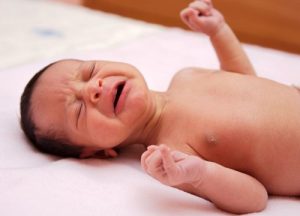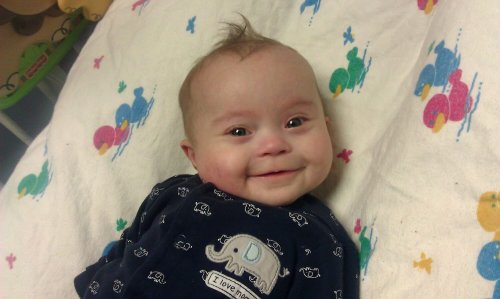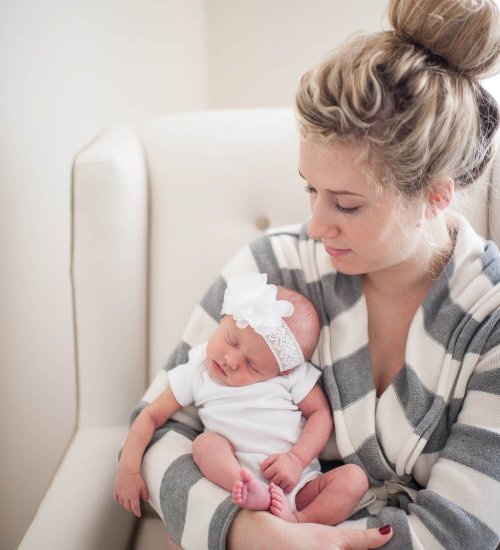Torticollis in Babies

Torticollis is normally a painful condition and you may have experienced it at some time in your life. We sometimes call it a “crick” in the neck and it can happen especially after a night sleeping in a bad position.
Torticollis in babies can also occur. This is often because of a difficult delivery or because of improper positioning in the uterus. This condition can be known as congenital muscular torticollis or infant torticollis.
Most babies don’t experience any pain with torticollis, but they may have their head tilted to one side, or have trouble turning their necks. Fortunately, with simple exercises and/or appropriate position changes, the child will improve over time.
So how can we help babies with torticollis? The first thing we need is to be able to understand what this condition is.

What is torticollis?
Torticollis or “twisted neck” is a condition in which a baby or child has their head and chin tilted to one side. They’re tilted because of the pain he would feel moving it towards the normal position.
Having said that, the baby actually can’t physically put his head completely in a normal position. It’s called “congenital torticollis” if the child is born with this condition.
There are studies that have shown that approximately 1 in every 250 babies suffers from this condition from birth.
In some cases, acquired torticollis may occur at a later time after birth with the head and chin twisted in this direction. The baby with torticollis may seem to be in pain, but not necessarily.
If there is pain it will come from the bad head and neck posture they have. Ideally, if you see your baby’s head tilted to one side, whether they’re in pain or not, you should go to your pediatrician. They’ll be able to assess the condition.
The symptoms of torticollis in babies
Torticollis in babies may be suspected when the baby experiences problems trying to tilt or move their head. You can even notice it when you hold your baby in your arms.
To know if it really is torticollis you should consider the following symptoms which are quite clear in these cases:
- Their head is tilted in one direction
- They look over one shoulder instead of turning their head completely to follow a movement
- The baby prefers breastfeeding on one breast as they may find it difficult on the other
- They have difficulty moving their heads completely in a particular direction and become frustrated when they can’t do it
In addition to these symptoms, there are also other conditions that can develop from torticollis. It’s important to know what these are in order to differentiate them.
The next step is to go to the pediatrician as soon as possible to assess the condition:
- Positional plagiocephaly (flat head syndrome). This can happen on one or both sides of the head as a result of always lying on a particular side
- Development of a small lump or swelling in the neck, similar to a knot in a strained muscle

Possible causes of torticollis in babies
There are different factors that may cause torticollis in babies. We need to know how it’s caused in order to find the most appropriate treatment in each case.
Although it isn’t a common condition in babies, it is a condition that can occur. Because of that, parents should be aware of what can cause it.
Narrowing of the sternocleidomastoid muscle
Congenital torticollis usually develops when the muscle that connects the sternum and the clavicle to the skull (sternocleidomastoid muscle) narrows and tightens.
This oppression may be due to abnormal positioning in the uterus (head tilted in one direction). Another possibility is that the muscle may have been damaged during labor. This condition is called “congenital muscle torticollis.”
Abnormalities in the cervical vertebrae
Abnormalities in the formation of the cervical vertebrae are less common. They may be the cause of congenital torticollis, a condition known as “Klippel-Feil Syndrome.“
In this case, the neck bones may be fused together, abnormally formed, or a combination of both. All of this could cause torticollis.
Hereditary diseases
Congenital torticollis may be caused in rare cases as a result of serious medical conditions.
These conditions can cause damage to the nervous system or muscles, damage to the brain or a tumor on the spinal cord. This is also hereditary and, due to this, it can also occur in babies.
Torticollis is normally a painful condition and you may have experienced it at some time in your life. We sometimes call it a “crick” in the neck and it can happen especially after a night sleeping in a bad position.
Torticollis in babies can also occur. This is often because of a difficult delivery or because of improper positioning in the uterus. This condition can be known as congenital muscular torticollis or infant torticollis.
Most babies don’t experience any pain with torticollis, but they may have their head tilted to one side, or have trouble turning their necks. Fortunately, with simple exercises and/or appropriate position changes, the child will improve over time.
So how can we help babies with torticollis? The first thing we need is to be able to understand what this condition is.

What is torticollis?
Torticollis or “twisted neck” is a condition in which a baby or child has their head and chin tilted to one side. They’re tilted because of the pain he would feel moving it towards the normal position.
Having said that, the baby actually can’t physically put his head completely in a normal position. It’s called “congenital torticollis” if the child is born with this condition.
There are studies that have shown that approximately 1 in every 250 babies suffers from this condition from birth.
In some cases, acquired torticollis may occur at a later time after birth with the head and chin twisted in this direction. The baby with torticollis may seem to be in pain, but not necessarily.
If there is pain it will come from the bad head and neck posture they have. Ideally, if you see your baby’s head tilted to one side, whether they’re in pain or not, you should go to your pediatrician. They’ll be able to assess the condition.
The symptoms of torticollis in babies
Torticollis in babies may be suspected when the baby experiences problems trying to tilt or move their head. You can even notice it when you hold your baby in your arms.
To know if it really is torticollis you should consider the following symptoms which are quite clear in these cases:
- Their head is tilted in one direction
- They look over one shoulder instead of turning their head completely to follow a movement
- The baby prefers breastfeeding on one breast as they may find it difficult on the other
- They have difficulty moving their heads completely in a particular direction and become frustrated when they can’t do it
In addition to these symptoms, there are also other conditions that can develop from torticollis. It’s important to know what these are in order to differentiate them.
The next step is to go to the pediatrician as soon as possible to assess the condition:
- Positional plagiocephaly (flat head syndrome). This can happen on one or both sides of the head as a result of always lying on a particular side
- Development of a small lump or swelling in the neck, similar to a knot in a strained muscle

Possible causes of torticollis in babies
There are different factors that may cause torticollis in babies. We need to know how it’s caused in order to find the most appropriate treatment in each case.
Although it isn’t a common condition in babies, it is a condition that can occur. Because of that, parents should be aware of what can cause it.
Narrowing of the sternocleidomastoid muscle
Congenital torticollis usually develops when the muscle that connects the sternum and the clavicle to the skull (sternocleidomastoid muscle) narrows and tightens.
This oppression may be due to abnormal positioning in the uterus (head tilted in one direction). Another possibility is that the muscle may have been damaged during labor. This condition is called “congenital muscle torticollis.”
Abnormalities in the cervical vertebrae
Abnormalities in the formation of the cervical vertebrae are less common. They may be the cause of congenital torticollis, a condition known as “Klippel-Feil Syndrome.“
In this case, the neck bones may be fused together, abnormally formed, or a combination of both. All of this could cause torticollis.
Hereditary diseases
Congenital torticollis may be caused in rare cases as a result of serious medical conditions.
These conditions can cause damage to the nervous system or muscles, damage to the brain or a tumor on the spinal cord. This is also hereditary and, due to this, it can also occur in babies.
This text is provided for informational purposes only and does not replace consultation with a professional. If in doubt, consult your specialist.








